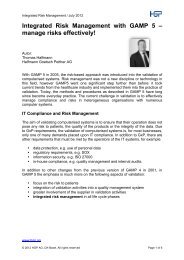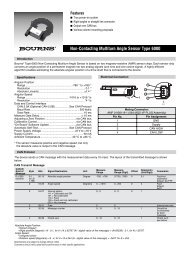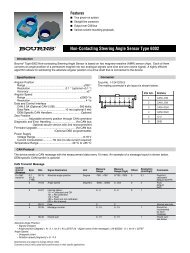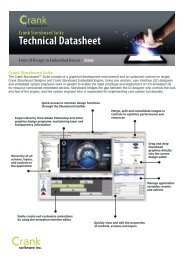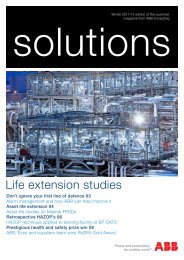Emerson Innovations Newsletter - we.CONECT
Emerson Innovations Newsletter - we.CONECT
Emerson Innovations Newsletter - we.CONECT
Create successful ePaper yourself
Turn your PDF publications into a flip-book with our unique Google optimized e-Paper software.
“The comprehensive<br />
energy management<br />
project is expected to<br />
reduce po<strong>we</strong>rhouse<br />
energy consumption by<br />
three to five per cent.”<br />
Andrew Rees<br />
Senior Engineer, Tata Steel<br />
Read the full story on pages 8 and 9
Making a difference<br />
for those in the know<br />
Contents<br />
“The combination of the EDF Energy Asset Management Specialists and <strong>Emerson</strong><br />
service experts working together to develop detailed work processes for streamlined<br />
maintenance practices, and the use of real time data and plant diagnostics, will move<br />
West Burton CCGT towards world class maintenance practices.”<br />
Darren Ramshaw, Engineering and Maintenance Manager, EDF Energy<br />
EDF Energy’s new Combined Cycle Gas Turbine (CCGT) po<strong>we</strong>r station at West Burton in the UK, places<br />
significant focus on compliance with governmental regulations and the safety of plant personnel and<br />
assets such as instruments and process equipment. <strong>Emerson</strong>’s AMS Suite predictive maintenance software<br />
will help optimise maintenance practices at the plant and enable the plant’s managers to quickly access<br />
integrated asset health information from multiple data sources, view real-time analyses and reports, and<br />
develop management strategies to improve plant performance. www.<strong>Emerson</strong>Process.com/IM001<br />
“Micro Motion Coriolis flowmeters have<br />
all the approvals <strong>we</strong> need, as <strong>we</strong>ll as<br />
providing the accurate and reliable data<br />
that this fiscal application demands.”<br />
Philippe Fauvel, Cryostar<br />
Micro Motion ® Coriolis flowmeters have European,<br />
Asian, Australian and U.S. approvals for cryogenic<br />
fluids in custody transfer applications.<br />
www.<strong>Emerson</strong>Process.com/IM002<br />
“Based on a successful implementation, at<br />
some point in the future <strong>we</strong> are perhaps,<br />
looking towards a plant with no wires.”<br />
Emmett Martin, Site Services & Automation<br />
Manager, GlaxoSmithKline<br />
<strong>Emerson</strong>’s Smart Wireless technology is enabling<br />
GlaxoSmithKline to monitor water usage at its<br />
Cork plant in Ireland.<br />
www.<strong>Emerson</strong>Process.com/SmartWireless<br />
“Based on our recent positive experience<br />
with the DeltaV system’s electronic<br />
marshalling, <strong>we</strong> know <strong>we</strong> can rely on<br />
<strong>Emerson</strong> to deploy this game-changing<br />
functionality on our PVC project.”<br />
Franck Jouault, System Manager for<br />
Solvay Tavaux<br />
<strong>Emerson</strong>’s DeltaV electronic marshalling and<br />
CHARMS increases project flexibility and reduces<br />
cost while reducing downtime at Solvay plant.<br />
www.<strong>Emerson</strong>Process.com/IM004<br />
“<strong>Emerson</strong>’s Smart Wireless experience<br />
was far in front of other vendors, and this<br />
experience gave us great confidence with<br />
our own application.”<br />
Nicolas Delfosse, Process Engineer Surface<br />
Chemistry, AkzoNobel<br />
AkzoNobel improves storage tank heating control and<br />
gas vent monitoring using Smart Wireless technology.<br />
www.<strong>Emerson</strong>Process.com/IM005<br />
Welcome to innovations.<br />
This issue of <strong>Innovations</strong> introduces <strong>Emerson</strong>’s<br />
new approach to energy management…one that<br />
turns nearly 100-year old models upside down.<br />
For many manufacturers, energy has become<br />
the largest single component of their operating<br />
costs. While much effort has been spent up to now<br />
in improving process system yields and energy<br />
consumption, little concerted effort has been<br />
spent on reducing the cost of energy generation<br />
at process facilities. Today, the energy generation<br />
and distribution areas of process plants represent<br />
significant areas for improvement and merit a<br />
rene<strong>we</strong>d focus on their operation.<br />
That’s why <strong>Emerson</strong> is announcing its Smart<br />
Energy Initiative…a global programme aimed at<br />
helping manufacturers make significant changes<br />
in their energy and emissions profile. This<br />
initiative focuses on helping customers lo<strong>we</strong>r the<br />
cost of energy, reduce emissions and improve<br />
reliability of their energy production<br />
and operation.<br />
We do this through a combination of world class<br />
consultants backed by the broadest range of<br />
technologies which enable customers to take<br />
full advantage of every opportunity to improve<br />
operations and lo<strong>we</strong>r their costs.<br />
This combination of Expertise and Innovation<br />
is helping customers achieve unprecedented<br />
results…some of which <strong>we</strong> will share with<br />
you here.<br />
Bob Sharp<br />
President, <strong>Emerson</strong> Process Management Europe<br />
Sustainable energy efficiency<br />
Smart energy initiative<br />
Improving energy efficiency<br />
Innovative technologies<br />
Further information<br />
4 & 5<br />
6 & 7<br />
8 & 9<br />
10 & 11<br />
12<br />
The contents of this publication are presented for<br />
informational purposes only and, while every effort has<br />
been made to ensure their accuracy, they are not to be<br />
construed as warranties or guarantees, express or implied,<br />
regarding the products or services described herein or<br />
their use or applicability. All sales are governed by our<br />
software licensing agreement and terms and conditions,<br />
which are available upon request. We reserve the right<br />
to modify or improve the designs or specifications of our<br />
product and services at any time without notice.<br />
<strong>Emerson</strong> and the <strong>Emerson</strong> logo are trademarks and<br />
service marks of <strong>Emerson</strong> Electric Co. ©2011 <strong>Emerson</strong><br />
Electric Co. All other marks are the property of their<br />
respective owners.<br />
2 3
SUSTAINABLE ENERGY<br />
EFFICIENCY<br />
Independent<br />
energy<br />
management<br />
consultant,<br />
David Stockill explains how<br />
advanced instrumentation<br />
and control systems are<br />
fundamental to achieve<br />
sustainable energy<br />
management improvements.<br />
Energy saving initiatives in the process industry<br />
have had a chequered history. A regular part of<br />
industrial life, especially since the end of “cheap<br />
oil” in the mid 1970s, the tools and techniques<br />
are <strong>we</strong>ll known and can generate an attractive<br />
earning po<strong>we</strong>r. But industry has not moved on to<br />
new higher levels of energy efficiency. Universal<br />
feedback from suppliers and customers points to<br />
issues surrounding the long term sustainability<br />
of improvement programmes. Benefit erosion<br />
is common. Yet in simple terms energy saving<br />
appears attractive – solid, understandable<br />
technology and good payback.<br />
How does this come about?<br />
Whilst single large CapEx items can make a<br />
structural change in energy performance (e.g.<br />
installation of a co-gen unit) a plant’s energy<br />
performance is generally driven by a large set of<br />
(sometimes conflicting) factors:<br />
• Adherence to operational targets<br />
• Maintenance activities (equipment efficiency<br />
and reliability)<br />
• Employed technology<br />
• Design standards<br />
• Culture and competency<br />
• Balancing yield/margin/energy<br />
There is no single factor that “sets” energy.<br />
Operating environments continually change.<br />
Energy efficient operation requires continual<br />
attention to all these factors.<br />
As a result, energy has often “slipped through<br />
the gaps” and has deteriorated at the expense of<br />
short term gains and budgetary pressures. This<br />
was not helped by low energy prices in the early<br />
2000s. Priorities <strong>we</strong>re elsewhere.<br />
There is no magic “silver bullet”. Sustainable<br />
energy efficiency requires a combination of<br />
technology plus procedural and housekeeping<br />
approaches and is being encapsulated in the<br />
new standards on Energy and CO 2<br />
Management<br />
(e.g. ISO 50001). Detailed point solutions are<br />
typically simple and <strong>we</strong>ll known but the overall<br />
management is a more complex picture.<br />
Fundamentally it is a control problem; both at<br />
a management level – using process data to<br />
Improvment<br />
Programmes<br />
Management<br />
Systems<br />
Benchmarking<br />
Industrial<br />
Best<br />
Practise<br />
Energy Management Process<br />
Increased Margin<br />
CO2 Reduction<br />
Reduced<br />
Environmental<br />
Impact<br />
analyse performance and drive improvement,<br />
and at an operational level – using modern<br />
control techniques to operate closer to (energy<br />
efficient) constraints. Accurate, reliable plant<br />
energy measurements plus a Distributed Control<br />
System and Process Historian provide the<br />
foundation to build a consistent approach to<br />
energy management.<br />
This must be complemented by Systematic<br />
Management to ensure long term sustainability<br />
and drive improvement. This sets the entire<br />
corporate framework in which the differing<br />
levels of control operate. ISO 50001 specifies<br />
requirements for an organisation to establish,<br />
implement, maintain and improve an Energy<br />
Management System. It applies to all aspects<br />
affecting energy use, which can be monitored<br />
and influenced by an organisation.<br />
The key approach is adopting a fit-for purpose<br />
vision, which defines the aims and provides<br />
the basic checks on management commitment<br />
and organisation, together with step-by-step<br />
approach to operational improvement.<br />
• Review current energy management<br />
effectiveness<br />
• Define management responsibilities<br />
• Develop simple performance review<br />
• Identify and implement initial low level<br />
applications. Quick wins<br />
• Review and Improve.<br />
The picture emerges of high quality process<br />
energy measurements, archived in a site-wide<br />
process historian, accessed through useroriented<br />
(PC) interfaces. Modern control,<br />
modelling and data analysis tools utilise this<br />
data. New measurement techniques (e.g.<br />
wireless technology) allow easy access to energy<br />
variables, which <strong>we</strong>re traditionally excluded<br />
from plant instrumentation. Surrounding this<br />
is a formalised management process, which<br />
determines the accountabilities and processes<br />
to ensure continuous performance appraisal and<br />
improvement.<br />
Increasing energy costs are here for at least<br />
the mid-term. Greenhouse gas issues will<br />
not go away. Energy efficiency is back on the<br />
agenda; it is a tangible link bet<strong>we</strong>en day-to-day<br />
industrial operation and emissions that can be<br />
influenced at all levels. Unless previous cycles<br />
are to be repeated, the adoption of systematic<br />
management techniques coupled with modern<br />
control technology is an essential strategy in<br />
ensuring long term sustained energy efficiency.<br />
David was formerly Shell Group Subject Matter Expert<br />
for Energy Management Systems, where he developed<br />
the world-wide standards and Energy Management<br />
work processes. David is now the Managing Director<br />
of Stockill Energy Management Services.<br />
www.stockillenergy.co.uk<br />
4 5
SMART ENERGY INITIATIVE<br />
Rising fossil<br />
fuel prices<br />
and global<br />
mandates for<br />
reduced emissions demand<br />
more than incremental<br />
efficiencies in energy<br />
management - explains<br />
Chip Rennie, Director of<br />
Global Industrial Energy<br />
for <strong>Emerson</strong> Process<br />
Management. That’s why<br />
<strong>we</strong> have introduced our<br />
Smart Energy Initiative - a<br />
fundamentally new platform<br />
that can change energy<br />
economics globally.<br />
For many industrial companies, energy comprises<br />
30% or more of a facility’s overall operating costs.<br />
When this is combined with higher prices for fossil<br />
fuels and new global emissions mandates, it’s no<br />
surprise that industrial customers are increasingly<br />
looking to waste fuels, biomass, and other<br />
renewable sources as a solution to these challenges.<br />
To enable customers to use more renewable fuels,<br />
lo<strong>we</strong>r energy costs and reduce emissions, <strong>Emerson</strong><br />
has announced the “Smart Energy Initiative”,<br />
a global programme designed to combine its<br />
unmatched industrial energy expertise with<br />
advanced energy management technologies.<br />
<strong>Emerson</strong> technologies and expertise provide<br />
the industry’s only turnkey energy optimisation<br />
programme to help refiners, chemical producers,<br />
and other manufacturers significantly reduce<br />
energy costs and emissions.<br />
<strong>Emerson</strong>’s new Industrial Energy Group will<br />
specifically focus on modernising and improving<br />
the performance of po<strong>we</strong>rhouses, the onsite<br />
utilities that provide steam and electricity to po<strong>we</strong>r<br />
industrial operations, while also improving how<br />
the manufacturing process consumes energy.<br />
Improving energy efficiency at a customer site by<br />
just 1%-2% can translate into hundreds of thousands<br />
of euros in savings, and substituting waste fuel for<br />
purchased fuel can save millions of euros annually<br />
New patent-pending innovation<br />
At the heart of <strong>Emerson</strong>’s integrated technology<br />
platform is its “True Energy” technology, a<br />
patent-pending innovation for calculating the<br />
actual calorific values of fuel sources, which<br />
makes reliable energy production predictable and<br />
repeatable.<br />
For the first time, <strong>Emerson</strong>’s proprietary suite<br />
of software, combined with field control<br />
technologies, enables the po<strong>we</strong>rhouse to<br />
interchangeably use the most available and<br />
affordable renewable or waste fuels to consistently<br />
create steam to po<strong>we</strong>r their operations. It also<br />
delivers 21st century combustion solutions for<br />
greater efficiency and reliability when using waste<br />
and other renewable fuels.<br />
Helping customers meet global emissions<br />
mandates<br />
Modernising industrial po<strong>we</strong>rhouses for greater<br />
sustainability not only reduces energy costs but<br />
also helps companies reduce emissions and meet<br />
global regulatory mandates. There has been<br />
tremendous growth for certain projects, such<br />
as biomass-to-energy conversion, where many<br />
customers are running on renewable fuels 95% of<br />
the time.<br />
Recent applications of <strong>Emerson</strong>’s industrial energy<br />
solutions include increased steam production from<br />
scrap wood at a commercial po<strong>we</strong>r facility, more<br />
stable operation of a university’s utility boilers,<br />
and more stable and efficient consumption of byproduct<br />
gases at a steel mill.<br />
<strong>Emerson</strong> expertise and critical technologies<br />
<strong>Emerson</strong> technologies that add real-time<br />
intelligent capabilities to the energy-generating<br />
process are <strong>Emerson</strong>’s SmartProcess Boiler and<br />
SmartProcess Energy Management software.<br />
SmartProcess Boiler technology delivers realtime<br />
combustion control solutions to address the<br />
inconsistent nature of renewable and waste fuel<br />
sources, automating and simplifying management<br />
of sudden changes in calorific value or the<br />
availability of those fuels.<br />
SmartProcess Energy Management runs in realtime,<br />
closed-loop control to balance steam<br />
systems, manage electrical demand swings and<br />
upsets, identify opportunities to buy and sell<br />
po<strong>we</strong>r, improve efficiency, and run an entire<br />
industrial utility at the lo<strong>we</strong>st cost automatically.<br />
www.<strong>Emerson</strong>Process.com/IndustrialEnergy<br />
6 7
IMPROVING ENERGY<br />
EFFICIENCY<br />
Boiler upgrades<br />
are helping<br />
Tata Steel make<br />
better use<br />
of ‘indigenous’ waste fuels<br />
that are by-products of the<br />
manufacturing process, explains<br />
Andrew Rees, manager of the<br />
upgrade project. The upgrades<br />
are part of a comprehensive<br />
energy management project<br />
that will help Tata Steel achieve<br />
its vision of becoming energy<br />
self-sufficient.<br />
Tata Steel’s Port Talbot facility in Wales is Britain’s<br />
largest integrated steel mill, making over four<br />
and a half million tonnes per year of high-quality<br />
sheet steel for the automotive, construction and<br />
household appliance markets. It includes two<br />
blast furnaces and a basic oxygen furnace, as <strong>we</strong>ll<br />
as continuous casters and a strip rolling mill.<br />
Tata operates seven steam boilers at the site<br />
and these require frequent attention by plant<br />
operators and the use of supplemental natural<br />
gas to compensate for the varying energy content<br />
of the waste fuels being used. Tata needed to<br />
increase energy efficiency and maximise the<br />
use of waste fuels, reducing emissions as <strong>we</strong>ll as<br />
reliance on purchased fuels.<br />
<strong>Emerson</strong> has already upgraded controls on three<br />
of the site’s steam boilers and Tata decided to<br />
upgrade the controls of its largest steam boiler<br />
using energy management technologies and<br />
services from <strong>Emerson</strong> Process Management.<br />
The boiler upgrades are helping Tata make better<br />
use of ‘indigenous’ waste fuels – such as blast<br />
furnace gas, BOS (basic oxygen steelmaking) gas<br />
and coke oven gas – that are by-products of the<br />
manufacturing process. The improved controls<br />
are part of a comprehensive energy management<br />
project that’s expected to reduce po<strong>we</strong>rhouse<br />
energy consumption by three to five per cent and<br />
help Tata Steel achieve its vision of becoming<br />
energy self-sufficient.”<br />
<strong>Emerson</strong> conducted a study to identify<br />
opportunities for improving po<strong>we</strong>rhouse<br />
operations at the Port Talbot facility, as <strong>we</strong>ll as<br />
providing an integrated combustion control,<br />
burner management, and energy management<br />
solution. The solution included <strong>Emerson</strong>’s<br />
SmartProcess Energy and SmartProcess Boiler<br />
optimisation technologies, DeltaV digital<br />
automation system with model predictive control,<br />
DeltaV SIS process safety system, Rosemount ® and<br />
Micro Motion measurement instruments, Fisher ®<br />
control valves, and Bettis and Hytork valve<br />
actuators. <strong>Emerson</strong> also trained Tata’s operators<br />
using a simulator installed in the po<strong>we</strong>rhouse,<br />
enabling them to gain experience with the new<br />
controls without affecting operations.<br />
Following the upgrade, operational stability has<br />
greatly increased, and energy costs have decreased<br />
as better use of waste fuels has reduced the need<br />
for natural gas. Using more waste fuel to po<strong>we</strong>r<br />
the boilers instead of burning it in flares also helps<br />
reduce emissions. And the new safety system<br />
enables an orderly process shutdown if necessary.<br />
“Using waste fuels is an attractive way to reduce<br />
costs and emissions, but it’s also challenging<br />
because of their variable energy content,”<br />
said Chip Rennie, director of <strong>Emerson</strong> Process<br />
Management’s Global Industrial Energy Group.<br />
“<strong>Emerson</strong>’s technology significantly reduces the<br />
effects of that variability so users can maximise<br />
low-cost fuel use – while consistently meeting<br />
steam demands. In a tough business climate,<br />
complicated by unpredictable energy prices<br />
and tighter emission controls, the winners will<br />
be companies like Tata Steel who turn those<br />
opportunities to their advantage.”<br />
www.<strong>Emerson</strong>Process.com/IndustrialEnergy<br />
8 9
Innovative<br />
Monitoring of steam traps and pressure relief<br />
valves, reduces steam trap failures and enables<br />
fuel cost reductions of 10-20% each year<br />
Wireless<br />
acoustic<br />
transmitter<br />
helps save<br />
energy and<br />
reduce<br />
environmental<br />
impact<br />
Steam production is a significant<br />
operating expense for processing<br />
plants and about 20% of the steam<br />
leaving a boiler is typically lost<br />
through failing steam traps. To help<br />
processing plants monitor these<br />
critical devices and significantly<br />
reduce their energy expenses and<br />
environmental impact, <strong>Emerson</strong><br />
has introduced the Rosemount 708<br />
Wireless Acoustic Transmitter.<br />
The new Smart Wireless<br />
device combines temperature<br />
measurement with acoustic<br />
“listening” that provides<br />
unparalleled visibility into the<br />
state of steam traps and pressure<br />
relief valves, without the effort of<br />
a manual inspection. This enables<br />
dramatic decreases in steam trap<br />
failures and fuel cost reductions of<br />
10-20% each year.<br />
The Rosemount 708 Wireless<br />
Acoustic Transmitter provides<br />
visibility to pressure relief valves<br />
by alerting operators when a valve<br />
has opened in as little as a single<br />
second. The time-stamped alerts<br />
can be compared against process<br />
conditions or environmental<br />
reporting to help identify the<br />
root cause of a release, so that<br />
preventive actions can be taken to<br />
reduce future emissions.<br />
Using a non-intrusive,<br />
WirelessHART ® monitoring<br />
system, operators can monitor<br />
traps throughout the plant, even<br />
in remote and hard-to-reach<br />
locations, with greater than<br />
99% data reliability. Real-time<br />
alerts identify which areas need<br />
attention, so operators can make<br />
informed decisions on how to act.<br />
The Rosemount 708 Wireless<br />
Acoustic Transmitter offers a fast<br />
and easy implementation and<br />
minimal on-going maintenance,<br />
taking advantage of the devices,<br />
tools, and knowledge already in<br />
the processing plant. The rugged<br />
transmitter features a 10-year<br />
battery life and engineered<br />
polymer housing that is intrinsically<br />
safe, <strong>we</strong>ather proof and chemically<br />
resistant.<br />
www.<strong>Emerson</strong>Process.com/IM012<br />
Electronic Marshalling<br />
technology now available for<br />
hazardous locations<br />
I/O in hazardous areas traditionally requires<br />
explosion-proof mounting or isolation barriers. These<br />
approaches are costly, require space for additional<br />
barrier and termination cabinets, and need on-going<br />
maintenance to ensure safety requirements are met.<br />
IS CHARMs builds on the innovative Electronic<br />
Marshalling and single-channel characterisation<br />
module (CHARM) technology. This provides<br />
significant savings in system design, installation<br />
cost and ease of maintenance, with intrinsically<br />
safe circuitry for field wiring into hazardous areas,<br />
including Zone 1, Zone 0 or Class 1 Div1.<br />
www.<strong>Emerson</strong>Process.com/IM008<br />
New digital DP level technology<br />
improves performance and<br />
reduces costs<br />
DP measurement systems on tall vessels and<br />
distillation to<strong>we</strong>rs have traditionally required<br />
excessive lengths of impulse piping or capillary<br />
which are costly to install and require regular<br />
maintenance. <strong>Emerson</strong>’s Rosemount 3051S<br />
Electronic Remote Sensor system is a breakthrough<br />
technology that replaces mechanical impulse<br />
piping with two 3051S pressure sensors. Differential<br />
pressure is calculated in one of the two sensors<br />
and the system delivers improved performance,<br />
simplified installation and maintenance, and<br />
additional process insight and diagnostics.<br />
www.Rosemount.com/3051SERS<br />
Pinch valve allows automated<br />
control of low volume, sterile<br />
liquids<br />
Manually-operated pinch valves give inefficient<br />
and poor control when used for low flow rate, low<br />
pressure control of sterile liquids. <strong>Emerson</strong>’s new<br />
Baumann 85000 sanitary pinch valve provides fully<br />
automatic operation for high value applications<br />
within the biotechnical and pharmaceutical<br />
industries. Compact and light<strong>we</strong>ight, the 85000<br />
pinch valve with the FIELDVUE controller provides<br />
an installed equal percentage flow characteristic for<br />
control accuracy. The digital controller also enables<br />
valve diagnostics that monitor the operating health<br />
of the valve assembly.<br />
www.<strong>Emerson</strong>Process.com/IM010<br />
Monitoring of subsea<br />
production <strong>we</strong>lls improves<br />
offshore safety<br />
Accessing information from behind the casing in<br />
subsea production <strong>we</strong>lls has always been difficult.<br />
<strong>Emerson</strong>’s new instrument - the Roxar Downhole<br />
Wireless PT Sensor System – Annulus B will measure<br />
online and in real-time, previously inaccessible<br />
pressure and temperature information. The new<br />
wireless instrument attaches to the same cable as<br />
the reservoir monitoring gauges and will detect any<br />
variations in pressure behind the casing string. It will<br />
provide early warning of these conditions and allow<br />
remedial action to be taken.<br />
www.<strong>Emerson</strong>Process.com/IM011<br />
10 11
Further<br />
information<br />
<strong>Emerson</strong> Process Management is always looking for new and innovative<br />
ways to enable customers to connect with them. These include local country<br />
<strong>we</strong>bsites, the award winning <strong>Emerson</strong> Process Experts blog – which includes<br />
an automatic translation tool, social media pages and twitter.<br />
Websites<br />
Please visit www.<strong>Emerson</strong>Process.eu and select<br />
your country from the dropdown menu on the left.<br />
Blogs<br />
<strong>Emerson</strong> Process Experts<br />
Connecting with the people behind the<br />
technologies and expertise. Site equipped with<br />
automatic translation.<br />
www.<strong>Emerson</strong>Processxperts.com<br />
DeltaV News<br />
DeltaV - <strong>Emerson</strong>’s digital automation system for<br />
process control.<br />
news.easydeltav.com<br />
Modelling and Control<br />
The dynamic world of process control,<br />
site equipped with automatic translation.<br />
www.modelingandcontrol.com<br />
The <strong>Emerson</strong> Global Life Sciences Blog<br />
Timely, targeted and relevant information for<br />
professionals in the life sciences industry.<br />
www.emersonlifesciences.blogspot.com<br />
Analytic Expert<br />
Discussing the application of liquid<br />
and gas analysers.<br />
www.analyticexpert.com<br />
LinkedIn groups<br />
Enter the following group names into<br />
the search bar in LinkedIn<br />
DeltaV Digital Automation System<br />
DeltaV SIS Process Safety System<br />
<strong>Emerson</strong> Global User Exchange<br />
Syncade suite<br />
Micro Motion<br />
Facebook<br />
<strong>Emerson</strong> Process Experts<br />
www.facebook.com/<strong>Emerson</strong>ProcessXperts<br />
Micro Motion<br />
www.facebook.com/micromotion<br />
DeltaV<br />
www.<strong>Emerson</strong>Process.com/DeltaVFacebook<br />
<strong>Emerson</strong> Process Management<br />
www.facebook.com/<strong>Emerson</strong>ProcessManagement<br />
Rosemount Process Level<br />
www.<strong>Emerson</strong>Process.com/ProcessLevelFacebook<br />
Youtube<br />
www.youtube.com/user/<strong>Emerson</strong>PlantWeb<br />
www.youtube.com/user/DeltaVsystem<br />
www.youtube.com/MicroMotionVideos<br />
Micro Motion Online Community<br />
Online resource for Coriolis flow & density<br />
measurement. Contains a blog and forums.<br />
community.micromotion.com/home.php<br />
<strong>Emerson</strong> People<br />
twitter.com/#!/JimCahill/emerson<br />
People Active in Process Automation<br />
twitter.com/#!/JimCahill/pauto<br />
2012 EMERSON GLOBAL USERS EXCHANGE<br />
MAY 29-31, 2012 • DÜSSELDORF





